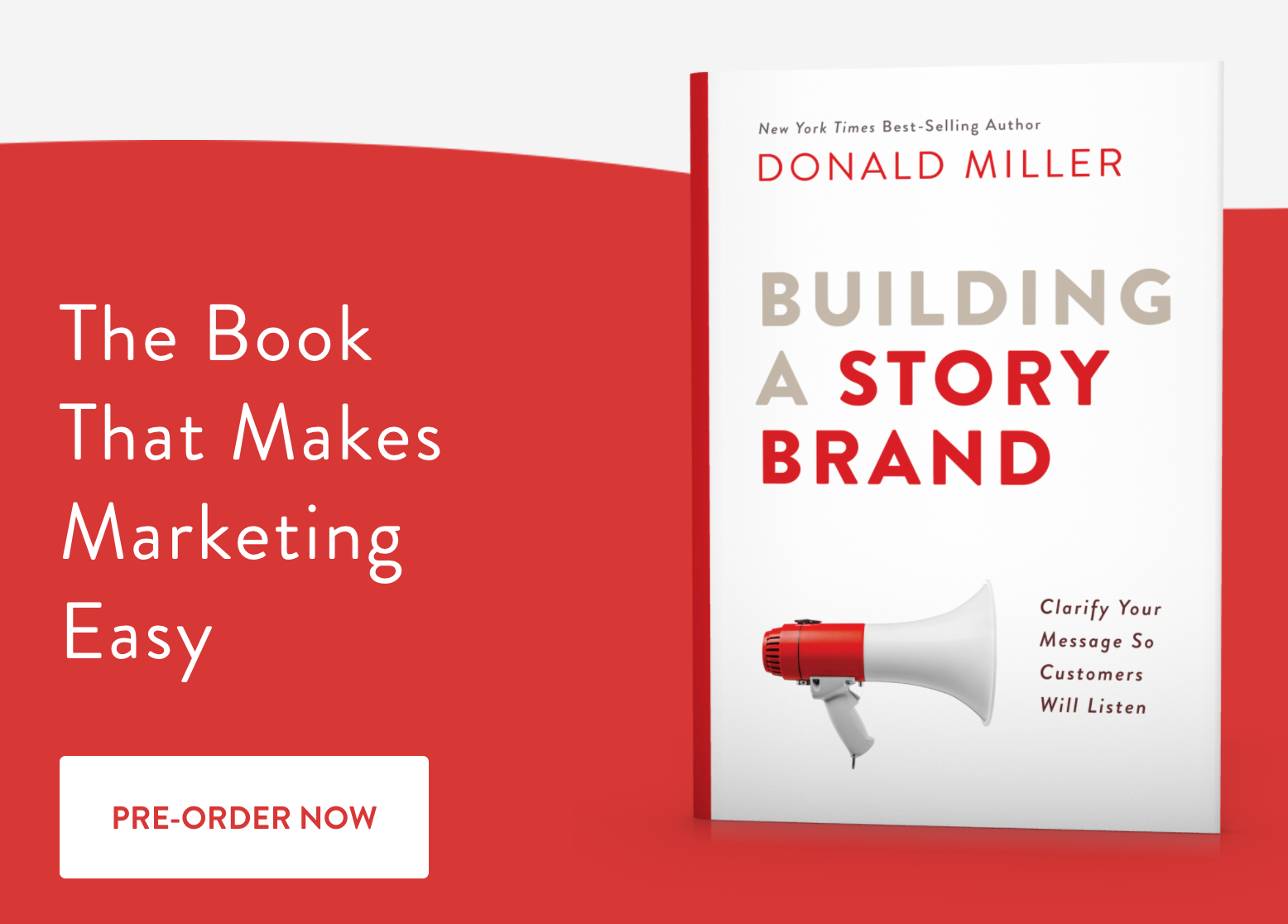
Episode Description
If you’ve ever tried to write sales copy for your product, then you’ve probably felt the intimidation of THE BLANK PAGE.
Worse, when you’ve finally beat the blank page blues, your copy doesn’t deliver the results you wanted. Your words fail to persuade your customers.
That’s why I’m thrilled to sit down with Ray Edwards on the Building a StoryBrand podcast. As the author of How to Write Copy That Sells, Ray’s going to reveal some magic phrases that will help you quickly fill up that blank page and make you money.
Ray is not only a highly successful copywriter. He’s also incredibly talented and experienced in teaching people about copywriting. Because he gives the most practical advice on the planet when it comes to writing copy, we give away his book to every client who comes to a StoryBrand Live Workshop.
After reading this blog post or listening to this podcast, you’ll have a few magic phrases to jumpstart your copy. You’ll no longer be intimidated by the blank page and you’ll find your sales copy is finally doing its job — reaching the people who need your product and making you money.
[LISTEN NOW ON APPLE PODCASTS]
#1: The If-Then Statement
“If you’ve tried all kinds of diets and exercise programs, bought all the gadgets from TV and none of them worked, then I’ve got something I think you’re going to be really interested in,” Ray quotes.
Sound familiar?
That’s because the If-Then statement is a powerful phrase that communicates directly to your customer. When the words that follow the “if” describe what your customer is experiencing or feeling, it acts as a hook to pull your client into a story loop.
When you follow the “then” with a description of what your product or service offers, you’ve set the hook and your prospects will keep reading to see if you can really deliver the answer to their problem.
Ray usually follows the if-then statement with a “here’s why …” because the next question your customer is usually going to ask is “Why am I interested?” By following this pattern, you’re naturally continuing a conversation that is engaging to your client.
#2: If You Don’t Do Anything … It Gets Worse
Newton’s second law of inertia states:
An object at rest will remain at rest unless acted upon by an outside force.
A StoryBrand corollary goes something like this:
Your customer will remain at rest unless you alert them to the negative consequences of doing nothing.
Ray says people tend to live in a state of denial. They believe that if they continue doing what they’ve always done, somehow a different outcome might happen.
“What I like to do is point out that it’s a flawed strategy,” Ray says.
You need to wake people up with your sales copy.
In the StoryBrand Framework, we talk about letting your customer know what’s at stake. Without stakes, there’s no story and your customer’s interest declines. Because people resist change, it takes an outside force (you) to get people to do something new or different.
The problem will get worse and Ray argues it’s your job to spell out how that’s going to look. You need to wake people up with your sales copy. Shake them from their inertia. Let them know that their situation will worsen if they don’t do anything different.
#3: What Most People Do…
In any business, service or product that you sell, there’s things that most people try to do to solve the problem that don’t work, Ray says.
A good way to highlight this is to use the magic words “What most people do …” and then list how those solutions fail, he points out.
This is a natural, conversational way to set yourself apart from your competition.
You may feel you’re stating the obvious, but you’re actually writing good copy. Remember, people are bombarded with thousands of messages a day.
Your customers are scanning through tons of information to find solutions for their problems. When you clearly write what is probably already going through their heads, your copy will resonate. And your prospect will keep reading.
#4: Imagine…
Imagine that your bottom line increased.
Imagine your amount of work decreasing.
Imagine you’re able to hire the staff you need without having to worry about whether you can make payroll every month.
To be able to command people to make a picture in their head and they obey it, is an amazing power we have.
Ray points out, “You imagined all those things because I told you to.” To be able to command people to make a picture in their head and they obey it, is an amazing power we have.
Why is this power so valuable?
“Because the goal of all advertising and marketing and selling is to get people to do one thing: to picture the successful outcome that your product will bring them,” Ray says.
By using this magic word, you’re helping people envision a successful ending to the narrative you’re inviting them into.
#5: If The Only Thing You Got Is…
The way to use this magic phrase is to figure out three or four valuable things your product delivers and then list them. It’s easier to illustrate the concept by example than explanation.
If the only thing you got from the StoryBrand Workshop was to double the effectiveness of your advertisement, it’d be worth it.
If the only thing you got from the book Building a StoryBrand was the ability to clarify your message so that you could tell people what you do in a way that doesn’t confuse them, it’d be worth it.
If the only thing you got from the StoryBrand Workshop was to make your business more profitable this year than it was last year, it’d be worth it.
Ray usually uses this magic phrase three or four times in the copy. He calls it “stacking the value.”
You finish this sequence off by stating that not only does your product do each of the things previously mentioned, it also does more.
“Now, you’ve just multiplied the value enormously,” Ray points out.
He says that great copy should convey the impression that whatever they’re buying is worth at least 10 times more than what we’re charging for it.
“I want to make the exchange easy to make,” Ray says. So should you.
#6: Don’t Let This Happen To You
It’s easier to sell headache pills than vitamins.
One of Ray’s mentors taught him this to illustrate that if you’re going to sell prevention, you’ve got to make them feel the pain right now.
In the StoryBrand Framework, you learn that as you guide your customer through their story, you should make them aware of the negative consequences of not doing business with you. We call it the failure category.
“I really think it’s important for people to realize that there are some basic emotions that we try to avoid when we’re engaging in any endeavor,” Ray says. “We don’t want to be embarrassed. We don’t want to be humiliated. We don’t want to be ashamed. We don’t want to be less than.”
When you’re talking to your customers, he adds that it’s fair to point out that you don’t want them to feel these emotions either. And if they keep going down the path they’re on, then it’s going to happen.
Enter the magic phrase: Don’t let this happen to you.
“People are already afraid it will,” Ray points out. “They’re just trying to deny it.”
I read a study that said when you’re trying to convince somebody to do something now that doesn’t benefit them now (it benefits them in the future), the brain processes their future self as another human being. For example, when your doctor tells you your blood pressure is a little high and you need to cut the salt, your subconscious tricks you into thinking that person who will have a heart attack is someone else.
It’s really hard to motivate someone to make changes today for a better tomorrow. By using this magic phrase, you’re waking people up to their future. You’re helping them recognize that their future self and present self are one and the same.
A caveat, however, and I explain this more in my book. Another study says that if you go too negative, people go into denial. They check out.
Ray agrees. To avoid crossing this line, he says it’s important to know your customers. By having real conversations with them, and taking the time to understand them, you’ll see when they’re starting to check out and you’ll know when to back off.
#7: What If… ?
This is a way of getting people to picture negative consequences without pushing too hard, Ray explains.
When you ask your customer what will happen if they don’t solve their problem, they fill in the blank in a personal way. They answer that question in their minds with relevant, on-the-nose feedback.
It’s another way of getting your clients to imagine the failure category, but the nice thing about it is it’s less direct, Ray points out. He’ll actually tell his customers to set the sales letter down, go to a journal and write out what will happen if they don’t take care of the problem.
“Let them work on it,” Ray says. “They’ll come up with their own reasons that’ll be much worse than anything you could come up with.”
#8: You’re Standing at the Crossroads
I think this one sounds cheesy.
Ray counters, “I know it sounds cheesy, but it works like crazy.”
I have to remind myself that Ray has consistently gotten great response for his copy. He knows what he’s doing.
Perhaps one of the reasons the “crossroads” analogy works so well is that it is an image people can picture in their minds. Ray takes the analogy further by describing the two different roads they can take. The road to the left is the way you’ve been doing things — it’s rough, rocky, and full of pitfalls. The way to the right is smooth, paved and leads to a sunny valley. Of course, he gets into the specifics of the product when he’s painting these pictures.
By the time he gets to the end of the sales letter and his customer is standing at the crossroads, Ray is making a much larger case.
“Now, you’re not asking them to buy or not buy a product,” he says. “You’re asking them, What kind of person are you? Are you the kind of person who solves this problem or are you the kind of person who doesn’t?”
It’s important to spell out what’s at stake.
If you object to using the word “crossroads”, you can substitute anything you like that makes it clear to your customer that it’s decision time. At the end of a sales letter, you’ve got to bring your prospect to a place where they choose.
At StoryBrand, we say you need to give them something to accept or reject. It’s important to spell out what’s at stake. Let them know what failure and success looks like. I actually find that putting the decision out there, getting it on the table, is really freeing. What you’re recognizing is that people will reject what you offer, and that’s okay! If you don’t give your customers a chance to make a decision, you’re taking away an opportunity for them to solve their problem.
—
Now that you’ve learned the magic phrases to jumpstart your sales copy, you’ll no longer be stumped by that blank page and you can begin making money with the words you write.
If you’re interested in learning more, Ray and I also have a course called The StoryBrand Marketing Roadmap, which takes you deeper into the ins and outs of writing copy that sells. Not only do we teach you the process of writing great sales copy, we walk you step-by-step through how to create a sales funnel. The how-to of writing sales copy is just a small part of all that you learn in this course.
Our purpose at StoryBrand is to help you succeed in your business. We want to make that happen for you. I hope by learning how to write persuasively, you’ll reach your customers and help them make a decision to change their lives for the better.

GET THE BOOK THAT MAKES YOU MONEY
Did you know you can get all the secrets to the StoryBrand Framework in one little book?
For less than $20, Building a StoryBrand will revolutionize the way you do marketing. Not only will it help you fix your website, you’ll learn how to talk about your business so your customers will listen.
You’ll also discover the real reason why people buy. And you’ll simplify your brand message so everyone on your team can talk about it in a way that captures prospects’ attention. After learning the StoryBrand Framework, your business will boom and you’ll have a competitive advantage in your field.
If you pre-order today, you’ll also get an audio lecture and a video lesson (a $148 value) by author Donald Miller to inspire you and build your motivation. Pre-order and get these two huge bonuses — free!
*To get your bonuses, purchase the book from any retailer and forward your receipt to bonus@StoryBrand.com.











